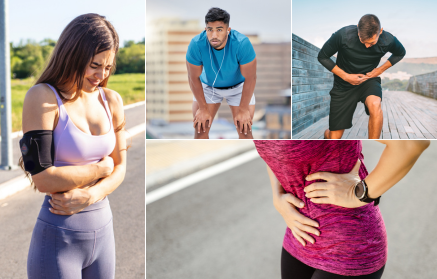Table of Contents
Probably every runner has experienced the feeling of running out, thinking that today is the day. They’re just going to go for it and give it their best shot. And maybe they’ll finally get some PRs in there. So with vigour the pace picks up, but that’s where it comes in. An uncomfortable feeling of a growing pain in the side that forces them to slow down or stop altogether. Well, hopes of beating their best times and good use of running session are dashed.
Therefore, in today’s article you will get acquainted with the most frequent causes of a stitch in the side, so that every runner knows how to prevent this problem. And we’ll also discuss how to deal with it once it occurs.
And if you’re considering giving running a chance, you shouldn’t miss the information in our article 11 Reasons to Start Running. How Will It Change Your Body?
What is a side stitch?
If you’re a regular runner, you’ve probably experienced a side stitch before, so you know exactly what we’re talking about. Just for the record, a year-long survey of runners found that 70% of them had experienced a stitch at some point. In a running race, it is estimated that 20% of participants experience this problem. [1-2]
A stitch in the side is abbreviated as ETAP (exercise-related transient abdominal pain). The mechanism that causes this unpleasant condition has been studied for many years, and it is still not completely understood. There are even more theories as to why it happens. Previously, it was the assumption that poor breathing was more to blame for the pain. The diaphragm is supposed to move up and down during this. However, when breathing is incorrect, it moves a little differently, and so it would lead to a stitch in the side.
Currently, scientists are leaning towards the possibility that it is caused by irritation of the outer peritoneum (the transparent membrane lining the abdominal cavity and part of the pelvic cavity), which rubs against the inner peritoneum when running. This theory was confirmed by a comprehensive review of 14 ETAP studies. [1-2]
This problem is manifested by pulling, tension or sharp and stabbing pain in various parts of the abdomen, most often under the right rib, which can vary in intensity and may even develop into cramps. In some people, the pain shoots up to the shoulder. Although this condition is not life-threatening, it can be quite distressing and make running uncomfortable. Often you have to slow down, change to a walking pace, or even stop completely.

You might be interested in these products:
Why do you get a side stitch?
Stitch in the side has several causes. If you experience it regularly, it can be quite an investigative job to discover why it’s happening. But the following points may help.
1. Running too intensely
When you run out of the house and immediately crank up your pace to top speed, you’re asking for a stitch. You’re more likely to get a side stitch when you’re breathing fast and shallowly than if you’re breathing deep into your abdomen on a slower run. [3-4]
2. Eating or drinking too much
With a full stomach, any physical activity can be pretty uncomfortable. Even a simple walk up the stairs can leave you panting after lunch. The same is true if you stuff yourself with a large meal before a run. A full stomach puts more pressure on the diaphragm, which again causes discomfort. And it’s the same if your stomach is full of water or sugary juice. [5]
3. Dehydration
We may have scared you with the previous point, so your response is to avoid liquids altogether for a few hours before a run? That’s not the ideal solution either. You can then quickly experience dehydration, which is defined as an excessive loss of body fluids and ions. Some of these, such as magnesium, then help prevent muscle cramps. According to some theories, even a stitch in the side is a form of cramp. Here too, it is appropriate to focus on prevention and do everything possible to prevent it from occurring. When you drink very little, the total volume of fluid and blood in the body is reduced as well. Proper blood flow is crucial for the functioning of the diaphragm. That’s why a proper water intake is so important.
If you want to learn more about when to use ion supply drinks, you shouldn’t miss our article Sports Drinks: When to Drink Ion Supply or Water?
Ion supply drinks are not the only supplements runners use, read more about them in our article The 11 Best Supplements for Running, Cycling and Other Endurance Sports.
4. Shallow breathing
Shallow breathing does not provide the muscles and the whole body with as much oxygen as deep breathing. Even the diaphragm doesn’t have a chance to work properly and perform its function. This, too, increases the risk of getting a side stitch. [6]

5. Running with poor posture
The results of studies suggest that poor posture could also cause stitches. For example, kyphosis, or excessive arching in the upper back, is a risk factor. [7-8]
6. Weak muscles
Side stitch is mainly related to weak muscles in the abdomen and back (the so-called core or deep stabilisation system). This also leads to poor posture, which again can cause a side stitch when running. [5]
7. Not warming up before running
Warm up and its importance is primarily discussed in the context of injury prevention. However, this is not the only reason. An insufficiently warmed up body affects the overall blood circulation in the body and thus also the diaphragm, which plays a key role in stitches. Warming up your body before a training session should therefore never be skipped. [5]
What to do to avoid getting a side stitch?
Now you know all the things that can cause a stitch. So let’s find out what you can do to minimise the risk of getting it.
1. Eat properly
If you are athletic, you’ll know that eating before an activity can make a big difference to how you feel. If you have deep-fried cheese and chips and tartare sauce half an hour before your run, you can’t expect to feel good. The optimal time to eat a larger meal is about 2 hours before running. The meal should contain all the macronutrients and be both balanced and easy to digest. If you need to, you can have a small snack, such as half a banana or half a protein bar about 30 minutes before activity.
But don’t take this as a universal rule. You need to test on yourself what food makes you feel good before a run. Some people may find vegetables harder to digest, others may find fattier foods harder. Keep trying, listen to your body and you will surely find the foods that are ideal for you and your digestion before a run. [5]
If you want to learn more about pre-workout nutrition, you shouldn’t miss our article What to Eat Before and After a Workout to Reach Maximum Results.

2. Don’t drink too much or too little
Optimal hydration is crucial for performance. In addition, it can help prevent side stitches. As we discussed above, a full stomach can put pressure on the diaphragm. Plus, a gurgling stomach is not pleasant. Avoid sugary drinks, too. These have been shown to aggravate side stitches as well. For longer bouts of exercise, when you need to drink, say, an ion supply drink, keep an eye on the quantity. Drink it in smaller amounts rather than downing the whole bottle at once. [5]
And don’t try to limit your water intake either. Lack of water can negatively affect your blood circulation due to lower blood volume. This also increases the risk of getting a stitch in your side. So try to drink adequately.
If you want to learn more about drinking and hydration, you shouldn’t miss our article How a Poor Water Intake Influences Your Health.
3. Warm up before running
Warm up is ideal for proper warming and optimal blood flow in the body, which will help with blood circulation to the diaphragm and other parts of the body. For a warm up, you can do exercises such as running alphabet exercises, jumping rope, a slow run, exercise bike, jumping jacks and other activities.
If you want to learn more about the importance of a warm up before exercise, you shouldn’t miss our article Warming Up, Stretching, and Cooling Down – Are They Really Important?
4. Increase your pace gradually
There’s no point in running out of the house at your top speed. With such a pace you would soon pass out, perhaps because of the stitch in your side. Especially in the beginning, don’t be afraid to alternate running with walking. And don’t overdo it even if you’re already well practised. Ideally, take a slower pace for the first kilometre and then gradually pick up the pace.
If you’re interested in how to get faster and better at running, you shouldn’t miss our article Is Running Boring? We’ll Reveal How to Love It and Keep Improving.

5. Focus on your breathing
Many runners breathe badly and then wonder why their side hurts. However, proper breathing technique is crucial for running. The key is to learn deep abdominal breathing with proper diaphragm involvement. This gets much more oxygen into the body than if you just breathe shallowly and superficially. If you’re unable to do this while running, practice the correct technique at home in a relaxed environment. If you get the hang of it, it will be much easier to breathe properly when you exercise. [6]
You can read more about how to breathe properly while running in our article How to Breathe Properly While Running and Why It’s Important?
6. Strengthen your body
A strong body improves performance even outside the gym. And running is no exception. In addition, it helps to strengthen the core, i.e. the deep stabilisation system, which improves overall posture. To some extent, this can also prevent side stitches. It is therefore ideal to include a comprehensive full-body strength training at least 2–3 times a week. So if you are a runner, it certainly doesn’t mean that strength training is not for you, quite the opposite. It’s another aid to keep you running further and faster. [8]
Do you want to exercise effectively and strengthen your whole body? Then you shouldn’t miss our article How to Create a Quality Gym Workout Plan?
And if you’re wondering what benefits weight training has for your joints, then you shouldn’t miss our article Does Running Damage Your Knees and Other Joints?
7. Choose the right clothes
This point applies especially to women who like to wear tight clothes. If you want to wear shorts or leggings for a run that you wore when you were several kilos lighter and they are tighter than you would like, leave them at home. Too tight waistband in leggings can make it difficult to breathe into your abdomen. You’ll be forced to breathe only superficially, which again can lead to a stitch in your side.
All clothing should fit the body just right. And if you feel like you need to buy some new items, we recommend checking out our new collection.
And if you’re wondering how clothing can affect performance in other ways, you shouldn’t miss our article How Can a Bad Choice of Clothing Affect Your Health and What to Watch Out For?

First aid for a side stitch
Sometimes you may do the maximum, but you still get a side stitch. Every day is just not ideal. In this case, it is good to know the principles that work as “first aid”:
- Select a pace.
- Switch to walking.
- Stop completely.
- Press your palm slowly against the spot where you feel the stitch.
- Stretch, for example, sideways bends can help (if you feel the stitch in the left side, raise your left arm above your head and lean to the right, do the opposite if you feel the stitch in the right side).
- Bend over and breathe deeply, focusing on deep diaphragmatic breathing.
- When the side stitch goes away, try running at a slow pace again. [2] [5]
If you’re interested in other tips to prevent side stitches, you shouldn’t miss our article What Not to Do Before Running? 10 Mistakes Every Runner Has Encountered.
What should you remember?
To some extent, you can prevent a side stitch by eating and drinking properly, running at a reasonable pace and not overdoing it at the beginning. However, there might be days when you do everything right, but still get a side stitch. At those times you just need to slow down, stop and do your best to make the problem go away. Then you can get back on track. If you get a stitch in your side, don’t worry about it, it happens to seasoned runners too. The next run will definitely be better.
Do you have someone among your friends who regularly complains of getting side stitches? Share our article with them so they know what helps best.
[1] Morton D. P. – Exercise related transient abdominal pain – https://bjsm.bmj.com/content/bjsports/37/4/287.full.pdf
[2] Darren Morton, Robin Callister – Exercise-Related Transient Abdominal Pain (ETAP) – https://www.ncbi.nlm.nih.gov/pmc/articles/PMC4281377/
[3] Side Stitch Won’t Go Away? Here Are 9 Likely Causes + Solutions – https://marathonhandbook.com/side-stitch-wont-go-away/
[4] Are you Neglecting your electrolytes? Guaranteed ways to prevent cramping – https://www.runningshoesguru.com/content/electrolyte_cramp/
[5] Garrett Koon et al. – Gastrointestinal considerations related to youth sports and the young athlete – https://tp.amegroups.com/article/view/14801/15747
[6] Budd Coates, Claire Kowalchik, Editors of Runner's World Runner's World Running on Air: The Revolutionary Way to Run Better by breathing smarter
[7] What causes a side stitch and how to treat and prevent it – https://www.medicalnewstoday.com/articles/side-stitch#what-is-a-side-stitch
[8] Darren P Morton, Robil Callister – Influence of posture and body type on the experience of exercise-related transient abdominal pain – https://pubmed.ncbi.nlm.nih.gov/20022301/


Add a comment